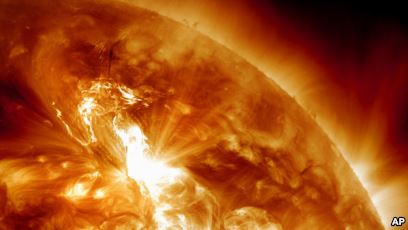
Someday, humans may be able to cope with the effects of population growth, such as famine, war and disease; but one thing is certain, the earth will eventually perish with all its contents.
Judgment Day? Maybe. But still long, about 6.5 billion years.
A report about the future of our sun shows, even though the earth may not be destroyed at all after the sun explodes, the only remaining remains will be a large, dry, frozen rock without any life.
The experts say, taking into account the present composition of the sun, as well as its evolutionary rate, it is estimated that the sun will die or burn up in a spate of helium gas explosions that will destroy approximately 40 percent of its weight.
According to the calculations of the experts, the earth still has about 6.5 billion years left before life on this planet can no longer be maintained. Because at that time, the sun will begin to swell, until it finally becomes a celestial body that is 200 times from now, and emits very high heat.
The high temperatures will evaporate all the water in the ocean, rivers and lakes, and kill all life forms on earth. Our present solar system, experts say, with one sun and eight planets circulating around it, including the earth, was created about 4.5 billion years ago.
The results of research on the sun or stars contained in other solar systems show that the sun we see each day, its age is almost half its life span, estimated at 12 billion years.
Experts classify the sun into the star of class G, measured from the level of light, and the color of radiation seen from the earth. Its surface temperature is now estimated at about 10,300 degrees Fahrenheit or 5,700 degrees Celsius.
Currently the sun is still in a stable main phase, where it continues to burn the supply of hydrogen gas contained in it. As a star of class G, the sun is expected to continue in that stage for another 6.5 billion years.
A report published in Astrophysical Journal magazine says, after the sun reaches the age of 11 billion years, the celestial body will enter the next phase of development, and become what is described as a red star giant.
The giant star is formed because the helium gas in its core explodes, so the sun is bubbled 200 times larger than its present size, and its light is 2,000 times brighter.
Then, for the next 150 million years, the temperature of the sun will fall again, because the helium contained in the core is gone. But then the helium gas found in the outer layers will explode in a row, and throw the crushed parts into space, so that the weight or mass of the sun will continue to decrease. A million years later, the sun continues to shrink in size, until the light is dim and eventually disappears altogether.
Before that, humans may have moved to another planet, as envisioned by the late famous astrophysicists, Professor Stephen Hawking, and Elon Musk, the great businessman who is preparing human flight to the planet Mars. The future man may be able to witness the dead system of the Solar System; as a dark star or black star surrounded by scorched planets.